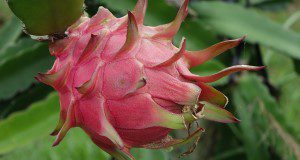Abstract
Dragon fruit, also known as pitahaya, pitaya, and strawberry pear, is a group of vine-like, climbing cacti. In south Florida, production of dragon fruit has been steadily increasing since the 2000s, and growers in Florida consider dragon fruit as a potential alternative fruit crop to avocado and citrus, two economically important fruit crops largely impacted by laurel wilt and huanglongbing, respectively. This new 4-page article focuses on the symptomology and epidemiology of stem and fruit canker, a prevailing disease on dragon fruit. Suggested management strategies for the disease are also discussed based on recent studies conducted in south Florida. Written by Cheng-Fang Hong, Shouan Zhang, Romina Gazis, Jonathan H. Crane, and Jeff Wasielewski, and published by the UF/IFAS Plant Pathology Department.
https://edis.ifas.ufl.edu/pp355
References
CDMS. 2019. “Crop Data Management Systems.” Crop Data Management Systems, Inc. Las Vegas, Neveda. http://www.cdms.net/
Crane, J. H. 2018. “Tropical Fruit Production in Florida – Trials, Tribulations and Opportunities.” Proc. Fla. State Hort. Soc. 131:ix-xii. https://journals.flvc.org/fshs/article/view/114701/110028
Crane, J. H., and C. F. Balerdi. 2006. Pitaya Growing in the Florida Home Landscape. HS1068. Gainesville: University of Florida Institute of Food and Agricultural Sciences. https://edis.ifas.ufl.edu/hs303
Evans, E. A., J. Huntley, J. H. Crane, and A. F. Wysocki. 2010. 2010 Cost Estimates of Establishing and Producing Pitaya (Dragon Fruit) in South Florida. FE888 (archived). Gainesville: University of Florida Institute of Food and Agricultural Sciences.
Ezra, D., O. Liarzi, T. Gat, M. Hershcovich, and M. Dudai. 2013. “First Report of Internal Black Rot Caused by Neoscytalidium dimidiatum on Hylocereus undatus (Pitahaya) Fruit in Israel.” Plant Dis. 97: 1513. https://doi.org/10.1094/PDIS-05-13-0535-PDN
Fullerton, R. A., P. A. Sutherland, R. S. Rebstock, T. H. Nguyen, N. A. T. Nguyen, T. L. Dang, T. K. T. Ngo, and V. H. Nguyen. 2018. “The Life Cycle of Dragon Fruit Canker Caused by Neoscytalidium dimidiatum and Implications for Control.” In Proceedings of Dragon Fruit Regional Network Initiation Workshop. 71–80. Taipei: FFTC. http://www.fftc.agnet.org/upload/files/activities/20180713134846/Paper_Dr_Bob_Fullerton.pdf
Hong, C. F., R. Gazis, J. H. Crane, and S. Zhang. 2019. “Prevalence and Epidemics of Neoscytalidium Stem and Fruit Canker on Pitahaya (Hylocereus spp.) in South Florida.” Plant Dis. https://doi.org/10.1094/PDIS-10-19-2158-RE.
Ni, H.-F., C.-W. Huang, S.-L. Hsu, S.-Y. Lai, and H.-R. Yang. 2013. “Pathogen Characterization and Fungicide Screening of Stem Canker of Pitaya.” J. Taiwan Agricul. Res. 62: 225–234. (https://www.tari.gov.tw/english/form/index-1.asp?Parser=20,15,101,82,,,3680,225,,,,18)
Unless otherwise specified, articles published in the EDIS journal after January 1, 2024 are licensed under a Creative Commons Attribution-NonCommercial-NoDerivs 4.0 International (CC BY-NC-ND 4.0) license.

